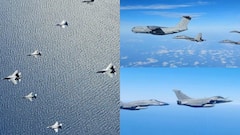Why PM Modi's Papua New Guinea Visit Is Significant As Chinese Influence Grows In Pacific Islands Region
Chinese intentions in the Pacific Islands region have drawn the attention of big powers like India and the USA who are now closely following the developments in the maritime region.

Prime Minister of Papua New Guinea James Marape revealed last week that Indian Prime Minister Narendra Modi will be visiting the country, as he expressed happiness over it. Though the Indian foreign office has not made any official announcement yet in this regard, this will be PM Modi’s first tour to the Pacific Island nation, and it is of great strategic significance, especially in the backdrop of growing Chinese strategic and economic footprint in the maritime area. India’s relations with the Pacific Islands region have now assumed relevance, not only in economic but from diplomatic and strategic perspectives also. This is why from India to the USA, all big powers are courting leaders of small Pacific Island nations that have a population of merely a few lakhs to less than a crore each. There are apprehensions that if the maritime region remains ignored, China may influence the small island nations to get under its security umbrella.
Beijing has in recent years launched its briefcase diplomacy and is trying to win their support. This has resulted in China entering into security cooperation agreement with Solomon Islands, situated very near Australian shores. A worried Australia and ally US are making strenuous efforts to dissuade the island countries from falling into Chinese trap.
Till a decade ago, these Pacific Island nations were out of the range of Indian foreign office radars, but Indian diplomatic interaction with these Islands gained momentum, with the organisation of first India-Pacific Islands conference held in Suva, the capital of Fiji, in November 2014, a country well known among the Indian masses because majority of its citizens have Indian roots. Modi, who had taken charge of the Indian government just a few months ago, went to Suva to address the first India-Pacific Islands summit. Though Papua New Guinea is not so well known among the common people in India, it is now occupying prime place in Indian foreign policy. A country of over 9 million, Papua New Guinea is the biggest island nation in the Pacific region, rich in mineral and other natural resources.
During the visit to Port Moresby, PM Modi would be addressing the third Forum For India-Pacific Islands Cooperation (FIPIC) Summit. The Indian PM would probably be in the capital of Papua New Guinea on May 22, and from there he will fly to Sydney for the QUAD Summit. Interestingly, US President Joe Biden would also be in Papua New Guinea this day where he will also be interacting with Pacific leaders where they are gathering for their annual meet. FIPIC includes 14 of the island countries — Cook Islands, Fiji, Kiribati, Marshall Islands, Micronesia, Nauru, Niue, Palau, Papua New Guinea, Samoa, Solomon Islands, Tonga, Tuvalu, and Vanuatu. Since the Indo-Pacific region also comprises the Pacific maritime area, the countries of the region have assumed great relevance. The Indo-Pacific four-nation alliance, QUAD, would like the Pacific Island nations to be a natural partner. Papua New Guinea PM Marape rightly acknowledged that “PNG and Pacific cannot be ignored” in the Indo-Pacific conversation.
Countering China's Cheque-Book Diplomacy
The Chinese move to bring the entire region under its strategic fold, however, has recently failed, with 10 of the island nations refusing to enter into a kind of security cooperation arrangement with Beijing. However, these Chinese intentions in the Pacific Islands region have drawn the attention of big powers like India and the USA who are now closely following the developments in the maritime region. Alarmed by last year’s security cooperation agreement signed between China and Solomon Islands, the Pacific powers are doing their best to discourage other Pacific Island countries from entering into such kind of relationship. Interestingly, four out of 14 Pacific Island nations — Marshall Islands, Nauru, Palau, and Tuvalu — have diplomatic relations with Taiwan. China is wooing these four nations to severe ties with its breakaway province.
With its cheque-book diplomacy China is trying to play a dominant role in the region. China is cajoling the island nations to join the Belt and Road Initiative( BRI) and offering them assistance in infrastructure development with Chinese technical and financial support. Chinese moves are getting scary for QUAD, which is holding a summit meeting just two days after pacific leaders gathering in Papua New Guinea capital.
Some of these Pacific Islands are underdeveloped and most vulnerable to climate change. Their economies are small and require external assistance for their well being. China is taking advantage of this and has become biggest trade partner after Australia. Currently this region has remained largely neutral in world politics, but form a solid block in UN, where India needs support of large number of member nations, big or small.
Though these island nations are relatively small in land area and situated far away from India, many have large exclusive economic zones (EEZs), and offer promising possibilities for fruitful cooperation, for India. Till now, India's focus has largely been on the Indian Ocean where it has sought to play a major role and protect its strategic and commercial interests. The FIPIC initiative marks a serious move to expand India's engagement in the Pacific region. To show its commitment for deeper partnership with the island nation, the then Indian President Pranab Mukherjee visited Port Moresby in 2016. Two years later, Chinese President Xi Jinping also landed there. Now, China has invited Papua New Guinea PM Marape to visit Beijing this year.
At present, the total annual trade between China and 10 Pacific Island nations is worth around $5.3 billion, whereas that between India and Pacific Island countries is only worth a meagre $300 million, out of which exports are around $200 million and imports are around $100 million. During the first FIPIC meet in Suva in November 2014, India had offered some major assistance projects. These comprised setting up of a special $1 million fund for adapting to climate change and clean energy, establishing a trade office in India, Pan Pacific Islands e-network to improve digital connectivity, extending visa on arrival at Indian airports for all the 14 Pacific Island countries, cooperation in space technology applications for improving the quality of life of the islands, and training to diplomats from Pacific Island countries. In addition, India has increased the annual grant-in-aid from $125,000 to $200,000 to each of the 14 Pacific countries for community projects of their choice, and launched a new Visitors Programme for Pacific Island Countries.
The second summit of the Forum for India Pacific Cooperation (FIPIC-2) was held in Jaipur on August 21-22, 2015 during which significant progress was made in strengthening India's engagement with the 14 Pacific Island nations. During the second summit of FIPIC, PM Modi announced thw opening of a FIPIC Trade Office at the Federation of Indian Chambers of Commerce & Industry (FICCI) to promote trade anf investment opportunities between India and Pacific Island countries. The third summit after a gap of eight years is creating excitement in Papua New Guinea, which eagerly awaits the arrival of the Indian prime minister.
The author is a senior journalist and strategic affairs editor.
[Disclaimer: The opinions, beliefs, and views expressed by the various authors and forum participants on this website are personal.]






































